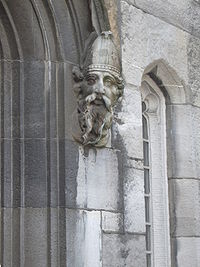.gif)
Edward Smyth (sculptor)
Encyclopedia
Edward Smyth was an Irish
sculptor.
 The son of a stone-cutter, Smyth was born in Meath
The son of a stone-cutter, Smyth was born in Meath
, Ireland
. He was employed by Henry Darley, who was in turn an employee of James Gandon
. By this connection Smyth met Gandon who was greatly impressed with his work. Gandon employed Smyth as sculptor to the Custom House
as well as for all of his Dublin projects. These included the Four Courts
, House of Lords
, and King's Inns
. Smyth was also employed by the architect Francis Johnston
. He carved the heads on the exterior of Johnston's Chapel Royal
in Dublin Castle
until his death, whereupon his son John continued the work.
Smyth was the first Master of the Dublin Society School of Modeling and sculpture. He died suddenly on 2 August 1812, at his home at 36 Montgomery Street in Dublin. His son, John Smyth, was also a sculptor and succeeded him as Master of Modeling at the Dublin School.
Irish people
The Irish people are an ethnic group who originate in Ireland, an island in northwestern Europe. Ireland has been populated for around 9,000 years , with the Irish people's earliest ancestors recorded having legends of being descended from groups such as the Nemedians, Fomorians, Fir Bolg, Tuatha...
sculptor.

County Meath
County Meath is a county in Ireland. It is part of the Mid-East Region and is also located in the province of Leinster. It is named after the ancient Kingdom of Mide . Meath County Council is the local authority for the county...
, Ireland
Ireland
Ireland is an island to the northwest of continental Europe. It is the third-largest island in Europe and the twentieth-largest island on Earth...
. He was employed by Henry Darley, who was in turn an employee of James Gandon
James Gandon
James Gandon is today recognised as one of the leading architects to have worked in Ireland in the late 18th century and early 19th century. His better known works include The Custom House, the Four Courts, King's Inns in Dublin and Emo Court in Co...
. By this connection Smyth met Gandon who was greatly impressed with his work. Gandon employed Smyth as sculptor to the Custom House
The Custom House
The Custom House is a neoclassical 18th century building in Dublin, Ireland which houses the Department of the Environment, Heritage and Local Government...
as well as for all of his Dublin projects. These included the Four Courts
Four Courts
The Four Courts in Dublin is the Republic of Ireland's main courts building. The Four Courts are the location of the Supreme Court, the High Court and the Dublin Circuit Court. The building until 2010 also formerly was the location for the Central Criminal Court.-Gandon's Building:Work based on...
, House of Lords
Irish House of Lords
The Irish House of Lords was the upper house of the Parliament of Ireland that existed from mediaeval times until 1800. It was abolished along with the Irish House of Commons by the Act of Union.-Function:...
, and King's Inns
King's Inns
The Honorable Society of King's Inns , is the institution which controls the entry of barristers-at-law into the justice system of Ireland...
. Smyth was also employed by the architect Francis Johnston
Francis Johnston (architect)
See Francis Johnson for English architect of similar name.Francis Johnston was an Irish architect, best known for building the General Post Office on O’Connell Street, Dublin.-Life:...
. He carved the heads on the exterior of Johnston's Chapel Royal
Chapel Royal (Dublin Castle)
The Chapel Royal in Dublin Castle was the official Church of Ireland chapel of the Household of the Lord Lieutenant of Ireland from 1814 until the creation of the Irish Free State in 1922...
in Dublin Castle
Dublin Castle
Dublin Castle off Dame Street, Dublin, Ireland, was until 1922 the fortified seat of British rule in Ireland, and is now a major Irish government complex. Most of it dates from the 18th century, though a castle has stood on the site since the days of King John, the first Lord of Ireland...
until his death, whereupon his son John continued the work.
Smyth was the first Master of the Dublin Society School of Modeling and sculpture. He died suddenly on 2 August 1812, at his home at 36 Montgomery Street in Dublin. His son, John Smyth, was also a sculptor and succeeded him as Master of Modeling at the Dublin School.

